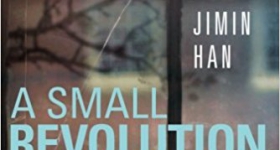The other day I ran into a warm and friendly colleague in my
English department who has an exasperating habit of dropping offensive remarks
into almost every conversation we have. This time, she’d been chatting with a
former student of hers who mentioned he was taking my class this semester.
“She’s not what I thought she’d be like,” this student told
her. Curious and amused, I asked her what he meant. She cheerfully replied, “Well, you know we
non-Asians automatically assume you Asians are all quiet and serious.”
The thing that killed me was that she wasn’t even joking. Even
worse -- that maybe, just maybe, there was the tiniest grain of truth in what
she said about what “non-Asians automatically assume” about all us Asians out
here. (Oh yes, I’m cringing too.)
As it happens, I’d just finished reading Susan Cain’s much
buzzed-about 2012 book Quiet: The Power
of Introverts in a World that Can’t Stop Talking, which was re-released in
paperback last month. Defining extroversion and introversion loosely along a continuum
rooted in biology, psychology, nurture, and culture (which I’ll come back to), Cain
describes how American culture has promoted and rewarded extroverted personalities
since the dawn of the twentieth century, and consequently devalued and even pathologized
introversion. This overwhelming emphasis on the self-promoting, booming-voiced “salesman
personality” type has come to dominate most of our esteemed and visible
cultural spheres, from the halls of Harvard Business School to the multiplex
megachurch and the open-plan workspace, as well as nearly every aspect of our
lives, including “who we are and whom we admire, how we act at job interviews
and what we look for in an employee, how we court our mates and raise our
children.”
But such pervasive attitudes are dangerously misguided, Cain
contends. At least one out of three Americans has an introverted personality,
and many of the most creative innovators and movers and shakers of our time -- including
Eleanor Roosevelt, Rosa Parks, Steve Wozniak, and our current president -- can
be categorized as introverts. In an interview on Amazon, Cain drew parallels between
the status of introverts today and of women at the cusp of second-wave feminism:
grievously wronged second-class citizens in a world designed to shut them
out. In part, therefore, Cain’s book positions
itself as a soft-spoken yet rousing manifesto aimed at nothing less than a
full-scale Introvert Revolution.
Indeed, after the book’s initial publication last year, introverts
came out of the woodwork in droves to (loudly) sing the book’s praises, pushing
Quiet to the top of national and
end-of-the-year bestseller lists. Thanks to Cain’s thoughtful, well researched,
and rapturously received work, introverts across America -- and indeed, the
world – finally felt acknowledged and validated.
As an avowed introvert, I was totally on board at first. Where have you been all my life, Susan Cain?
I thought as I raced through the pages. That is, until I started reading
Chapter 8. Then, things sort of screeched to a halt.
The chapter, titled “Soft Power: Asian-Americans [sic] and the Extrovert Ideal,” follows several
young Asian Americans from the largely affluent city of Cupertino, California
(home of Apple Inc.) over the course of four years as they transition from high
school to college. Cain’s aims in this chapter, presumably, are to set the
values of the town’s Asian American community in sharp relief against the
“extrovert ideal” of mainstream America and meditate on their differences.
“In the West, we subscribe to the Extrovert Ideal, while in
Asia (at least before the Westernization of the past several decades), silence
is golden,” Cain writes.
To my dismay, as that cliché-ridden line illustrates, the
subtle nuances that Cain employs throughout the rest of the book suddenly
disappear in this chapter. (Another embarrassing example: “From a Western
perspective, it can be hard to see what’s so attractive about submitting to the
will of others. But what looks to a Westerner like subordination can seem like
basic politeness to many Asians.” All this to segue into an anecdote about a
Chinese American Harvard Business student and his assorted roommate problems.)
Despite a paragraph-long disclaimer about not wanting to
encourage broad ethno-cultural stereotypes, such as “describing Asians as a
‘model minority’ -- even when meant as a compliment,” the rest of the chapter
proceeds to talk about “Asian cultural and personality styles” as if they were
a unified field. Cain makes little to no distinction between “Asian” and “Asian
American,” let alone the finer shadings within each: ethnic and national differences
are superficially pointed out but generally elided, along with class,
generational, and other crucial differences. Thus, the Cupertino kids -- who
themselves come from a wide range of backgrounds -- are discussed in virtually
the same breath as Chinese kids, Tibetan monks, Hiroshima victims, Japanese
proverbs, and Gandhi.
So how exactly do Asians (to use Cain’s main term) fit the
introvert bill? The handful of high school students she profiles indeed personify
attributes typically associated with introversion, at least in their
self-descriptions. But some people she interviews -- including a Cupertino woman
named Hung Wei Chien, who came to the U.S. from Taiwan in the ’70s for grad
school and whom Cain describes as “one of the most jolly, extroverted people I’ve
ever met” -- seem to be included in this chapter to round out a claim for a kind
of blanket “cultural” introversion that is nothing if not broad-stroked. For
example, when Chien laughingly describes her long-ago experience as the “quiet
student” in her linguistics class, Cain immediately chalks it up to Eastern
deference -- but couldn’t something else like, um, language barrier have been at
least part of the issue?
Since Cain’s own definition of introversion
is already fairly broad, based less in personality theory than in cultural
perceptions of the term (for which she has come under some criticism), her
attribution of an “introvert ideal” to virtually all Asian-related cultures unhelpfully
clouds the picture even more and -- what’s worse -- lumps Asians and Asian Americans under yet another model minority
myth. Ironically, Cain herself warns against the dangers of perceiving all
Asian Americans as quiet introverts, at least in the realm of business.

Author Susan Cain
In an
earlier blog post on her website, Cain cited a UC Riverside study in which
a group of businesspeople, given identical information about fictional employees,
consistently ranked Caucasian Americans as having higher leadership potential
than Asian Americans. When I first read
this, I thought that perhaps here Cain was making more nuanced claims than in
the book, but unfortunately this wasn’t the case. While she warns again against
cultural stereotyping, Cain is ultimately less interested in dispelling myths
than in considering the hypothetical scenario that “even if all Asian-Americans
[sic] were introverted, the
idea that quiet people can’t make good leaders is sheer nonsense.” In other
words, the very existence of the “Asian introvert” myth is just too useful to Cain’s
straw man argument here -- i.e., that “the idea that quiet people can’t make
good leaders is sheer nonsense” – for her to dispense with completely.
Indeed, in an uncomfortable echo of Tiger Mom (made explicit
in another
blog post subtitled “The Real Reason ‘Chinese Mothers Are Superior’”), Cain
argues in the chapter that despite her misgivings, she would rather risk
overgeneralizing about Asians than keep the valuable secrets of Asian
introversion from the public eye: “There
are too many aspects of Asian cultural and personality styles that the rest of
the world could and should learn from.” At this point in the book, I needed to
take a long break. Up to that point, I’d thought Cain was talking to introverts
like me; suddenly, I felt completely sidelined.
If I were supposed to be her audience, then why did I have to confront
an othered (and unrecognizable) ideal of “my” culture, so that I too could “learn
something from Asians” through Cain?
Surprisingly, it was hard to find others who shared this view.
In fact, I only found one: in an otherwise admiring review
of the first edition, Harvard student Faith Zhang briefly expressed unease over
Cain’s conflation of cultural and individual traits in this chapter. But this was a lone dissenting note in a sea
of critical praise. This is a damn shame,
because there’s much more at stake than just the elisions in this book. For if Quiet -- which values and, for the most
part, embodies the traits of perceptivity, sensitivity, and deep critical
thinking -- can rehash such sweeping generalizations about so-called “Asians,”
how much more pervasive and blunt-edged is this stereotype in other cultural
spaces and in our everyday lives?
Evidence, of course, is everywhere in our workplace, from
the aforementioned UC Riverside study to my frustrating run-ins with my
colleague. It’s happening in our schools, as numerous
studies
indicate, where stereotypes about the quiet, studious Asian super-scholar means
that Asian American students are resented by their peers, are called on less
often in class, and are less likely to receive help for overlooked emotional, social,
and psychological issues. And it’s
happening in our national discourses, from the overly sunny 2012 Pew
report on Asian Americans to the frequent
omission
of the 73% of Asian American voters who voted for Obama from the “majority-minority”
narrative of the 2012 election.
This large-scale, insidious pattern of cultural stereotypes
about the Quiet Asian -- whether in the guise of older model minority myths or
in newer forms like the “Asian introvert” -- continues to turn down the volume
on our heterogenous voices, identities, and communities day in and day out. Wearisome
as this conversation may seem, therefore, the re-release of Susan Cain’s Quiet provides an important opportunity to
push back-- loudly -- and work towards dismantling these stereotypes yet once
again.









Comments